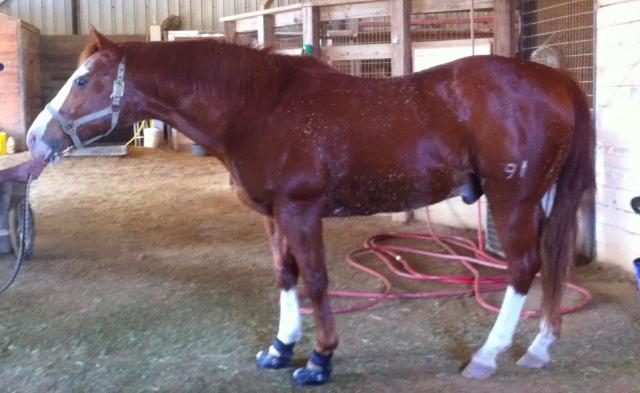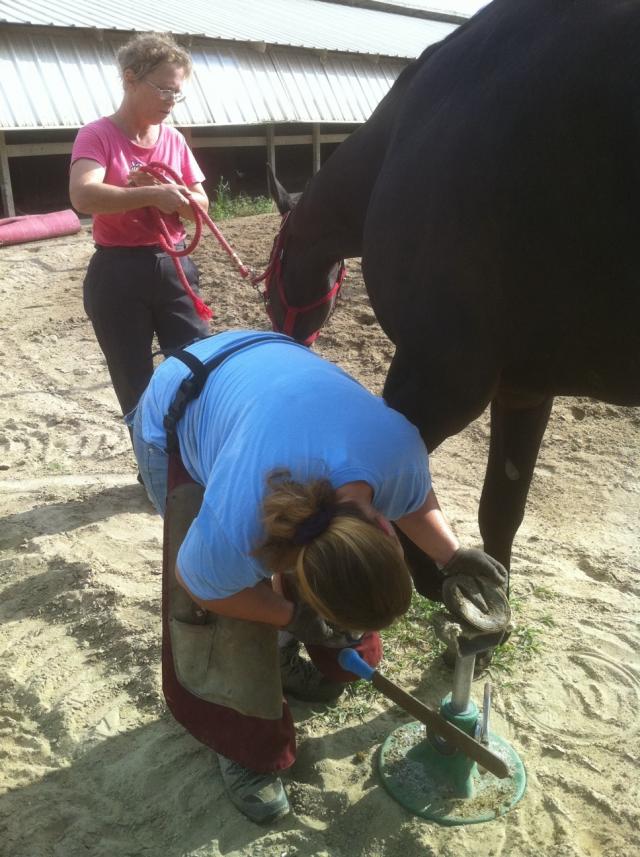I never thought I would ever trim for Thoroughbred race horses. After all, my barn is full of off-the-track race horses who have come to me with terrible feet. OK, so I currently only have 3 horses, and 2 of them are off the track thoroughbreds. But I have owned 5 of them myself, and trim many on a regular basis. From what I knew about the racing industry, race horses have three strikes against them when it comes to natural hoof care: A sweet feed diet; no turn out (although they do get galloped and walked on a wheel each day); and nail-on shoes on their feet. Certainly, there was nothing I was going to be able to offer to people in this corner of the horse world.
And yet, I had met a woman about 4 years ago, way before I knew I was going to become a trimmer, who did seem to have a very different approach to horse racing: an approach that sounded promising. I met Lisa Meaux when she was looking for a home for a newly-retired race horse named Blondie. My neighbor, knowing my love for Thoroughbreds off the track, suggested that my barn was the place for Blondie. I agreed before even meeting the horse, and so met Blondie and Lisa on the same day, when she pulled up to my barn with my new “present”.
Unlike other trainers, Lisa starts every young Thoroughbred by first working intensely on ground manners, using methods from Clinton Anderson. Once the horses begin their racing career, Lisa will incorporate other techniques not often seen in the racing industry, such as chiropractor, acupuncture, and message therapy to keep her horses happy and comfortable.
With her less traditional methods of training in mind, I figured just maybe she’d be interested to hear about my new exploits in natural hoof care. Low and behold, she was very excited to hear that I may offer something different from her track farriers! No, no. She wasn’t about to have me rush over to the track to start pulling the shoes off of her race horses. After all, no one down in Louisiana has ever heard of Thoroughbreds racing barefoot. However, her husband Victor Arceneaux did have a beloved pony horse at his farm who had been struggling with sore feet for over 2 years.

When I got to poor old “91”, he had shoes on all four feet, and large foam pads duck taped to the bottoms of his front feet in a desperate attempt to relieve his pain. 91’s shoes were pulled and I trimmed his aching feet while he stood on foam padding. Next, he was fitted with Easyboot Epics, and we discussed changing his feed from a sweet feed to a dry pellet. Lisa followed all of my suggestions with him, changing his feed to a low starch pellet, taking him off of pasture (necessary in cases such as severe obesity and EMS), making sure I trimmed him regularly, and getting him plenty of exercise in his new hoof boots. Within a few months, the horse that they were about to give up on was back to his old mischievous self– barefoot! Lisa and Victor were thrilled!
With this natural hoof care triumph, Lisa began pulling sore-footed race horses out of training for me to rehabilitate. I noted that the horses brought to the farm for rehabilitation had been left with no heel and no sole. Their feet were flat and their soles soft. Each horse was fitted with EasyBoot Epics (my personal favorites), their diet was changed to a dry pellet, and they were sent out to play and exercise.
In no time, Lisa was able to identify the healthy hoof as it grew from hairline to the ground, and noticed the difference in heel height and sole concavity that happens with natural hoof care, compared to farrier-shod race horse feet. She began bringing pairs of hoof boots over to the race track training center for any horses who showed lameness, and began requesting more and more for the farriers to leave shoes off of her horses at the track. And yes, she is now giving me a shot at a few of her thoroughbreds in training at the track!
Cautiously optimistic, I realize that there are many hurdles we have to face in this new adventure. After all, many in the racing industry still believe that a horse cannot race without shoes, and the few that do believe racing barefoot is possible also believe that barefoot horses wouldn’t have a chance against shod competitors. Then there are the issues with diet and exercise. Most horses in the racing industry are fed sweet feed, an enemy of the healthy hoof; and race tracks are certainly not known for their ample pasture space.
Am I getting in over my head? Possibly. But with one trainer willing to give natural hoof care a try, I feel that I have to gamble on a win for the barefoot horse, and for the chance of encouraging the racing industry to make changes toward healthier, happier athletes.





